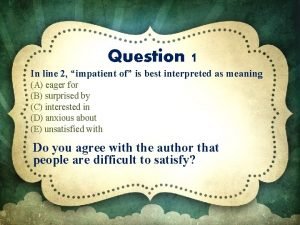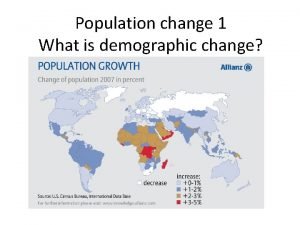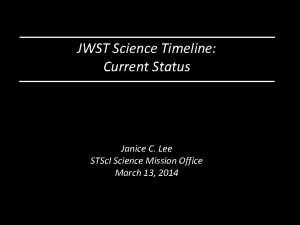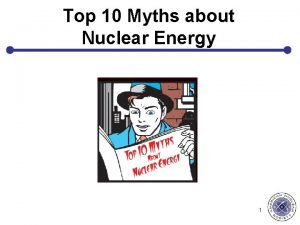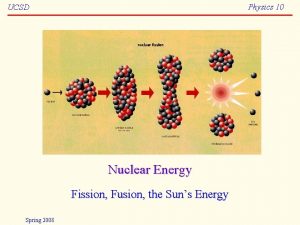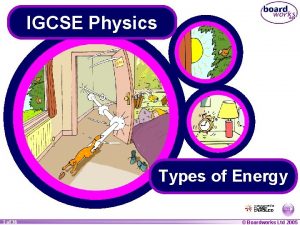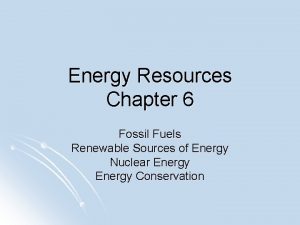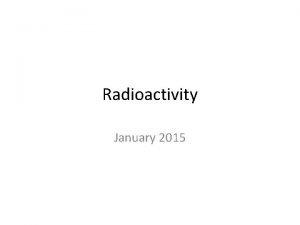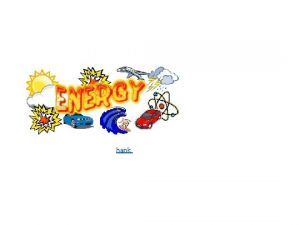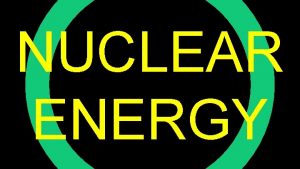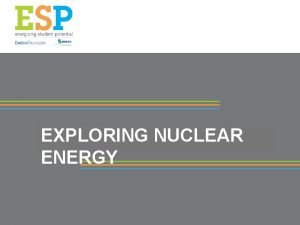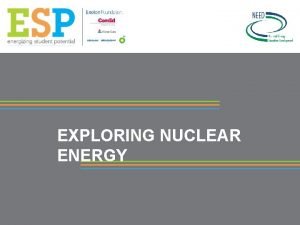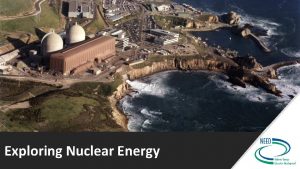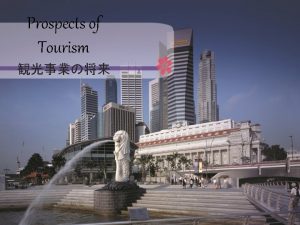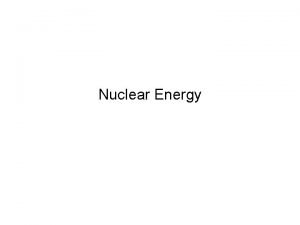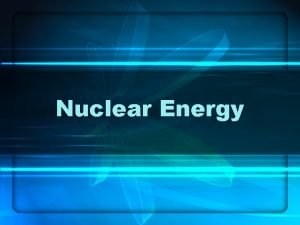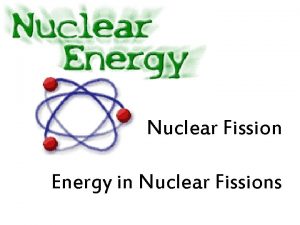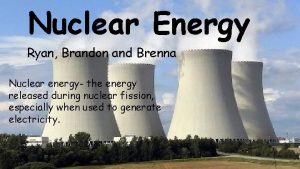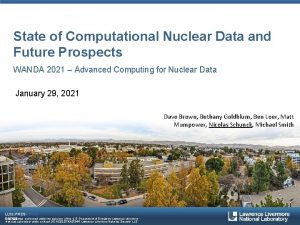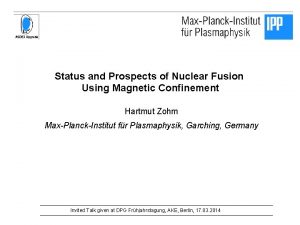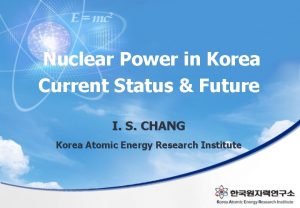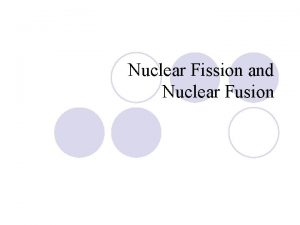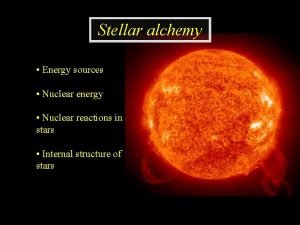Current Status and Future prospects of Nuclear Energy







































- Slides: 39

Current Status and Future prospects of Nuclear Energy in India and its Global context. R. Rajaraman Emeritus Professor of Physics J. N. U. , New Delhi and Co-Chair, International Panel on Fissile Materials 1

Ø It gives me great pleasure to thank HRI and Professor Sumathi Rao for the invitation to give this talk and also participate in the workshop on topological insulators. Ø Globally, Nuclear Energy has been undergoing a roller-coaster history since its inception 70 years ago, with a renewal of both interest and controversy in recent years. Ø In India too, it has become one of the most important and widely debated Science and Technology issues. Ø Therefore it is well worth talking about it in a 2 premier institution like HRI.

Ø However I did give a talk at HRI some years back on a related topic– the Indo-US nuclear Deal. So, before confirming my acceptance I managed to retrieve and go over my old talk to ensure that there will not be much repetition. Ø I don’t think there will be. That earlier talk dealt specifically with the Nuclear Deal, the different stages of its negotiations, its impact on the weapons program, the lifting of sanctions, its politics in India and in the US, the near-fall of the UPA government, etc. Ø In this talk I will discuss nuclear energy more generally -- its current status and future prospects both in India and abroad. Much has happened on the nuclear front in the past 5 years, including the Fukushima disaster. Ø To put things in perspective let me begin at the global level , and then go on to the Indian program. 3

Nuclear Energy at the Global Level Initial enthusiasm Ø When the nuclear era dawned Atomic (nuclear) energy seemed the ultimate solution to mankind’s energy needs. Ø The US started building nuclear reactors rapidly. Europe, the Soviet union followed suit. Ø India too started its nuclear program already in the late ‘forties. Ø Other developing countries were also encouraged to go nuclear by Eisenhower’s Atoms for Peace program 4

Subsequent Slow down Ø But a few decades later skepticism and opposition began to gather against nuclear energy in many countries. Ø Contributing factors: Ø Major reactor accidents like the 3 -mile Island in the US and Chernobyl in the USSR, Ø Greater safety and environmental consciousness, the Green Parties…… Ø Growing awareness of complexity and expense of Reactor Decommissioning and Spent fuel disposal Ø Although some countries like France, Russia, China and India continued with a their programs, the biggest producer, the US, stopped licensing of new reactors. Ø After building 100 reactors by the 1970 s , further growth was frozen for several decades ! Ø Germany also stopped increasing nuclear capacity (even before Fukushima). Ø Some advanced nations like Norway and Italy (which 5 produced Fermi) never had nuclear power reactors.

History of Global Nuclear Power Capacity (Note the steep rise followed by flattening) In 2005 there were 443 reactors generating 370 GWe 6

Nuclear Rennaissance? Ø Then just a few years back there seemed to be a revival, prompted by Ø (i) concern over climate change due the high Carbon emission by Coal and hydrocarbon fuels. Ø (ii) Improved reactor safety features and passage of two more decades of reactor use with no major accidents– making them ‘statistically’ safer. Ø The US government through its Nuclear Power 2010 Program and Energy Policy Act had initiated building of new nuclear power plants, and was expecting over 20 applications for 34 new plants. Ø Other countries also began to express interest in starting civilian nuclear programs 7

Projected Carbon Emissions (Robert Socolow) 8

Replacing Carbon emitting energy production Ø You can try to replace this green wedge by a variety of measures: Ø Carbon capture and storage, solar, wind, energy efficiency and conservation, nuclear fission……. Ø [Nuclear fusion is too far away to take solace from right now, or to incorporate in commercial energy planning] Ø To replace even 1/5 th of this wedge by nuclear fission energy will amount to adding an additional capacity of 1000 GWe globally over the 370 Gwe we now have Ø Is such a growth feasible in 45 years ? Ø Can the world absorb 1000 GWe more ? Ø Is there enough fuel? 9

U consumption depends on reactor type, but for example, for our CANDU type reactors 1 GWe ≈ 150 tons of U/year Conventional resources (U is main product): 14. 8 Mt. U Phosphate sources: 22 Mt. U There is more than enough Uranium to fuel the 1000 GWe for decades. 10

Many countries wanted to go nuclear Trevor Findlay CIGI report 2010 11

Not all countries can absorb large nuclear plants Trevor Findlay CIGI report 2010 IAEA: No single reactor should be > 10% of total electricity capacity 12

Then came Fukushima Ø As you know , the Fukushima reactor explosions had a massive impact (much more than Chernobyl) on public perceptions of nuclear energy. Ø The nuclear industry, hoping to enjoy a “renaissance” had instead to face charges of being unsafe and expensive. Ø Anti-nuclear activists worldwide felt empowered and demanded closure of nuclear reactors. Ø Different countries responded differently – a story unto itself. Germany decide to phase out its entire nuclear program in a decade. Other countries like the US , the UK, Russia , China and India conducted safety reviews to the extent they saw fit and decided to continue with their nuclear energy plans, but at a more cautious pace. Ø Those developed nations which had chosen not to go in for nuclear energy (New Zealand, Norway, Italy. . )carried a smug “I told you so” look. Ø As to those developing nations that did get caught up in the euphoria of the renaissance and wanted to get reactors of their own -- what they will do post -Fukushima remains to be seen. (UAE has gone ahead with plans to build 4 reactors in an $18 billion deal with S Korea) 13

Onward to India Ø In the background of this global history let us discuss how the Indian program has been doing. Ø The Indian program, formally begun in the late forties, has been enjoying steady support from the government since then. It has also grown steadily but rather slowly. Ø But in more than 6 decades, they have only been able to develop a capacity of less than 5 GWe, with another 2 GWe likely to be added this year. 14

Why was the development so slow? Ø One major factor was unavailability of funds. Till the 1990’s India was a “poor and developing” country. (Of course it still is, but that is a different story). You will see that only 6 reactors had been commissioned by then. Ø Then, around 1990, the government opened up the economy and the GDP started growing, along with the nuclear capacity growing from 6 to 20 reactors. Ø Another major factor was the imposition of sanctions by the international nuclear community after India’s nuclear test in 1974. No nuclear technology or materials could be bought from outside until the sanctions were lifted ( thanks to Indo-US deal). Ø Our Uranium ore is limited in quantity and quality. According to the IAEA “Redbook” we have only 84, 000 tons --- 54, 800 t. U as Reasonably Assured Resources and 29, 800 t. U as Inferred Resources. Our rate of mining is only 300 tons a year. 15 Ø So the program suffered from Uranium shortage as well.

So far India has built 20 reactors with a capacity of 4. 78 Gwe, about 2. 5% of our total electricity generation, with another 2 Gwe under construction Power reactor Date of commencement Type Power (MWe) Kaiga-1 16 -Nov-00 PHWR 220 Kaiga-2 16 -Mar-00 PHWR 220 Kakrapar-1 6 -May-93 PHWR 220 Kakrapar-2 1 -Sep-95 PHWR 220 Madras-1 27 -Jan-84 PHWR 220 Madras-2 21 -Mar-86 PHWR 220 Narora-1 1 -Jan-91 PHWR 220 Narora-2 1 -Jul-92 PHWR 220 Rajasthan-1 16 -Dec-73 PHWR 100 Rajasthan-2 1 -Apr-81 PHWR 200 Rajasthan-3 1 -Jun-00 PHWR 220 Rajasthan-4 23 -Dec-00 PHWR 220 Tarapur-1 28 -Oct-69 BWR 160 Tarapur-2 28 -Oct-69 BWR 160 Tarapur-4 12 -Sep-05 PHWR 540 Kaiga-4 2010 Tarapur-3 Aug 2006 220 Kaiga 3 2007 Kaiga-3 May 2007 220 Tarapur-3 2006 Kaiga-4 Nov 2010 540 Rajasthan-5 2009 Rajasthan-5 Nov 2009 220 Rajasthan 6 2010 Rajasthan-6 Jan 2010 220 Under Construction Kudankulam-1 VVER 1000 Kudankulam-2 VVER 1000 16

ALL INDIA INSTALLED GENERATING CAPACITY (MWe) OF POWER A Profile as of 31 Feb 2012 MWe COAL GAS DSL Subtotal Nuclear Thermal HYDRO Renew ables TOTAL 112022 1199 18381 131603 38990 24503 199877 4780. 00 17

India’s Future Energy Requirements (GWe) (Integrated Energy Policy, Planning Commission 2006, Table 2. 7) Year Total Thermal Hydro Nuclear Renew 2021 -22 301 231 41 26. 1 2. 7 2031 -32 551 430 61 57 3. 6 @8%growth 18

What of the future ? Projected Electricity Requirements (Bk. Wh/yr) 19

Ø Can India achieve the desired target of 25 GWe by 2020, let alone over 55 Gwe by 2030 ? Ø Certainly it could not have without the Indo-US Nuclear Deal and NSG lifting international sanctions Ø For one thing it doesn’t have enough indigenous uranium. The 84, 000 tons of assured reserves would not last even a dozen years, at the projected capacity of 50 Gwe. For another it does not have the capacity now to suddenly build 50 more reactors within two decades. Ø Fortunately, the consummation of the Indo-US Nuclear Deal in 2008 allows us to import uranium, which we have started doing. Ø It also allows us to enter into collaboration with other 20 countries on building reactors at a faster pace.

Progress after the Nuclear Deal Ø Agreement to make purchases of U with Kazakhstan, Namibia, Mongolia, Niger, Canada, (Australia ? ? ) Ø Sanctions against transfer of technology in many sectors were lifted although India has complained about continuing denial of some items and the NSG strictures against transfer of enrichment and reprocessing technology Ø Initial agreements were made for construction of reactors by foreign builders, Russia, France and the US to start with. Ø Note that there was no requirement in the Indo-US Deal (the 123 Agreement) that India buy US built reactors. Ø Indeed I do not agree with some Indian cynics that the primary motivation on the part of the US was reactor sales. Ø Rather it was the geopolitical and strategic value of increasing cooperation with India. Recall that India, a large democracy next door to China, was also (at that time !) enjoying rapid 21 economical growth and was considered a fast emerging power.

Ø Ø Construction of US built reactors It was also clear that not only the US, but other countries would also benefit from commerce with India– especially France and Russia, although it is the US that did the heavy lifting at the NSG and the US Congress to lift sanctions against India. This was a major act of statesmanship by the much reviled President Bush. Of course it was understood from the start that an additional benefit to both nations would be the possibility of US firms building some reactors in India But the Russians and the French were right off the block with their own reactor building offers as soon as the Deal was completed. In fact the Russians have proceeded farther ahead than the French or the US in their negotiations. 22

Russian built reactors Ø As everyone knows by now, the Russians had already been building two reactors for us at Koodangulam. Construction for these started even before the international sanctions were lifted. The sanctions were bypassed using what is known in the trade as “Grandfathering”, i. e. claiming that the agreement to build them had preceded the imposition of sanctions. Ø Other countries tacitly looked the other way (This often happens in the international community) Ø In addition to the Koodangulam reactors the Russians were offered a “reactor park” to be located at Haripur in West Bengal to house eight 1000 MWe Russian VVER plants. Ø (That site and similar ones offered to the French and the Americans may have to be shifted because of public protests; more on that later) 23

French Built Reactors Ø Meanwhile, the French reactor building giant AREVA has been allotted a similar reactor park at Jaitapur in Maharashtra. They are expected to build six EPR (European Pressurized reactor) units with a capacity of 1650 MWe apiece. Ø Caution: Areva is currently completing construction of an EPR in Finland which has escalated tremendously in cost and schedule 24

US built reactors Ø By March 2009, GE Hitachi (GEH) had signed Mo. U s with the Nuclear Power Corp of India Ltd (NPCIL) and Bharat Heavy Electricals Ltd (BHEL) to prepare for the construction of Advanced Boiling Water Reactors. Ø These Mo. U s would allow discussions to begin on the "techno-commercial aspects" of the Advanced Boiling Water Reactors ABWR of capacity 1350 Mwe each. Ø NPCIL also entered into agreements with Westinghouse on the construction of AP 1000 Pressurized Water Reactors (PWRs) Ø GE Hitachi and Westinghouse are expected to build over the years, a number of their ABWR or AP 1000 reactors at Mithi Virdi in the Saurashtra, and Kovada in 25 Andhra Pradesh.

Ø So everything looked hunky-dory for all concerned. There seemed to be plenty of room for everyone and no competition between the three major reactors building nations for contracts. The type of reactors and their costs being different in each case, negotiations with each supplier could be conducted separately. Ø But then two developments took place : Ø 1. India’s Nuclear Liability Bill Ø 2. The Fukushima Tragedy 26

Nuclear Liability Bill Ø In August 2010, the Indian government approved the Civil Liability for Nuclear Damage Bill. Ø Its discussion in the Parliament coincided with the 25 th anniversary of the Bhopal Gas tragedy. The overwhelming public opinion was that the victims of that chemical factory tragedy were not adequately compensated, the Indian government was slack and that Union Carbide had “gotten away with murder”. Ø The discussion of the Nuclear Liability Bill took place in the shadow of Bhopal. The coalition government had also expended much of its political goodwill and combative strength while pushing through the Nuclear Deal a few years back. Ø It capitulated to sentiments that it should not once again “sell out to US capitalist interests” by letting American companies off the hook with a “lenient liability law”. That France and Russia 27 were also involved scarcely figured in the debate

From the Nuclear Liability Bill Ø The Bill had several progressive measures including reactor operator liability of $300 million and a requirement that a claim for compensation by a victim will have to be dispatched within 3 months of application and the award accordingly made. Ø But it also contained a clause permitting the operator to sue the reactor suppliers: Ø …[the operators have 'right of recourse' against equipment suppliers if], as per Clause 17 (b) and (c) "the nuclear incident has resulted as a consequence of a willful act or gross negligence on the part of the supplier or act of commission or omission. . with the intent to cause damage”. Ø On the surface, such supplier liability may sound reasonable, for, if indeed it can be legally established that their actions led to the accident, they should pay the penalty. Ø But no other nuclear country includes such a condition Ø Is India therefore violating some international convention? The answer seems to be “yes”

CSC Ø According to the most recent instrument adopted, the Convention on Supplementary Compensation (CSC), the operator will be fully responsible for all liability in case of a nuclear incident Ø The convention does permit national laws to provide the operator with the right to recourse only "if it is expressly provided for by a contract in writing" or if the incident "results from an act or omission done with an intent to cause damage". Ø The Indian legislation, however, goes beyond this. It also states that the operator can exercise this right if "the nuclear incident has resulted as a consequence of latent or patent defect, supply of sub-standard material, defective equipment or services or from the gross negligence on the part of the supplier of the material, equipment or services". Ø India’s Liability Law does not conform to the mandatory stipulations in the CSC Annex, since it contains Clauses 17(b) (right to recourse) and 46 in addition to all other laws) Ø Meanwhile India had promised to the US as far back as in September 2008 to sign the CSC and did so in October 2010 despite these apparent conflicts with our Liability Bill.

Rules for the Liability Act Ø Not unexpectedly, all the suppliers from the US, France and Russia were unhappy with the supplier liability clause Ø In an effort to allay their concerns and to reduce conflict with CSC, the government notified a set of “Rules” (guidelines) for the operation of the Liability Bill, on November 11, 2011. It mitigated the Liability penalty quite a bit and clarified that Ø The provision for the right of recourse (from the supplier) shall be for the duration of initial license issued under Atomic Energy (Radiation Protection) Rules, 2004 or the product liability period, whichever is longer". The former is typically 5 years and the latter 1 year. This is much shorter than liability for the entire life of the reactor. Ø Since the maximum liability of the operator is Rs 1, 500 crore (US$ 300 million) as per the Act, Rule 24(1) states that the right of recourse from the supplier can in no case exceed that amount, whatever be the contract value ($4 -6 billion ? ) Ø The operator's claim shall in no case exceed the actual amount of compensation paid by him up to the date of filing such claim.

What next? Ø That may have satisfied the suppliers, but it is not the end of the Liability story. Ø Even these rules have to discussed by the appropriate committees of the Indian parliament. Opposition parties had introduced some amendments to the Rules to restore some of the more stringent spirit of the Liability Bill. Ø But as things stand these amendments haven’t been passed by the parliament either. Ø There also legal and constitutional issues regarding whether the rules “carry out the purpose” of the original Act and whether the Act itself conflicts with the CSC. Ø (See for example Leading jurist Soli Sorabjee interviewed in The Hindu, Dec 13, 2011. ) Ø So the precise legal situation is murky. But it may be sufficiently murky that savvy lawyers can squeeze out sufficient legal space to enable foreign companies to agree to build reactors in India. After all, tens of billions of dollars and three major nations are involved!

Reverberations of Fukushima Ø As you know , the Fukushima reactor explosions had a massive impact (much more than Chernobyl) on public perceptions of nuclear energy. Ø The nuclear industry, hoping to enjoy a “nuclear renaissance” in last few years because of climate change concerns, had instead to face charges of being unsafe and too expensive. Anti-nuclear activists worldwide felt empowered and demanded closure of nuclear reactors. Ø Different countries responded differently – a story unto itself. Germany, Japan, the US , the UK. . . Ø In India the government conducted a full safety review and decided to continue with its plans for further 32 expansion.

Protests Ø But activists organized major protests against the proposed new reactors , especially at Kudangulam where two Russian built reactors were getting ready to be commissioned – surprising since traditionally in India protests were rarely aimed at Russian built facilities (power of Fukushima and the collapse of cold war behavior patterns). Ø Another site allotted to the Russians at Haripur in W Bengal may have to be relocated because of the opposition of the local political party Ø Similarly Areva’s EPR reactors planned at Jaitapur on the west coast has been met with local opposition. Protests were organized during President Hollande’s 33 visit to Delhi.

Ø So one problem that India is going to face in any of its nuclear expansion projects whether with the US, Russia or France will be public protests from a mixture of environmental, radiation and human displacement concerns. Ø I personally believe that the real driving force behind such “not on my backyard” protests is not nuclear hazards, but possible loss of livelihood of the local people, and inadequate compensation and support for those displaced, Ø These are very legitimate grievances. But this problem is common to all major new projects requiring large tracts of land – whether they be river dams , car factories or Copper mines. It is a problem to which the government has to find a uniform, fair solution. It is in the process of coming to grips with this and proposing new legislation. Ø Meanwhile these protests will perhaps slow down nuclear collaboration with the US but , I suppose, will not prove fatal. 34 Ø The unresolved Liability issues and reactor costs are the more serious obstacles.

Ø Worldwide, the abandonment or significant roll back of nuclear energy expansion would have been a retrograde step, especially for developing nations whose per capita availability of electrical energy is a tenth of what, say, Germany enjoys. The world needs every source of energy including nuclear. Ø While there is some danger associated with nuclear energy, there are other hazards associated with lack of electricity for the hundreds of millions of people in developing countries. Ø In India over 30% of rural households and a hundred thousand villages do not have electricity. Unlit roads are unsafe for women, unlit homes are bad for children’s eyesight and education, rural hospitals with constant power breakdowns can be deadly. Ø The actual hazards of nuclear power have to be in balanced some meaningful sense against no power or alternate power sources. 35

Ø Governments as well as social activists must be pro-active in educating the public about nuclear hazards, Ø but in a responsible and balanced manner. Neither bland assurances that there is no danger, nor the stoking of hysterical fears will serve the public good. Ø The public response to Fukushima in many nations shows lack of faith in official assurances (even China: iodine pills)). Ø Even the general intelligentsia, let alone the lay public, does not have the technical background for making up its own mind about nuclear safety. It has to take someone’s word for it. Ø But, who will give them required assurances when the people best qualified to do so are increasingly disbelieved? Ø So nuclear agencies everywhere , not just India, must work to regain public trust if nuclear expansion is to proceed speedily, especially in a democracy. 36

THANK YOU 37

From S. K. Apte, India’s Nuclear Energy Programm, INSA Symposium 2012 Source of Exposure Average annual Dose at 1. 6 km radius of India’s NPPs Dose (m. Sv) 0. 002 -0. 036 One year exposure to natural radiation 2. 4 One chest x-ray 0. 05 - 0. 1 Air travel (50, 2 h trips) Radiation limits (common man / radiation worker) Space station per year 0. 4 1 / 20 (50 -250) 170 A-bomb survivor (mean dose) 200 --------------------------------------------------10 milliseiverts ≈ 1 rad

Ø Coming to the proposed US built reactors, GE is supposed to build 4 reactors with a total capacity of 8, 000 MW at Mithi Virdi on the Saurashtra coast. Other US plants are planned in Kovada, on Andhra coast. Ø Protests have started in both these places but not gathered full strength since the physical process of site clearing and construction has not started yet. But the Saurashtra plant has already drawn criticism since it falls in the seismic zone III, where a major quake killed 39 thousands in 2001.
 Future continuous tense and future perfect exercises
Future continuous tense and future perfect exercises Future perfect continuous and simple
Future perfect continuous and simple Quantum computing progress and prospects
Quantum computing progress and prospects Lesson 15 nuclear quest nuclear reactions
Lesson 15 nuclear quest nuclear reactions Fisión nuclear vs fision nuclear
Fisión nuclear vs fision nuclear In line 2 impatient of is best interpreted as meaning
In line 2 impatient of is best interpreted as meaning Prospects of agriculture in bangladesh
Prospects of agriculture in bangladesh World population prospects
World population prospects Prospects preposition
Prospects preposition Current and future trends of media and information essay
Current and future trends of media and information essay Y connected generator
Y connected generator Line current and phase current
Line current and phase current Drift current and diffusion current
Drift current and diffusion current Lesson 4 three-phase motors
Lesson 4 three-phase motors Drift current density unit
Drift current density unit Ceramic composition resistors
Ceramic composition resistors Balanced delta-wye connection
Balanced delta-wye connection Holding current and latching current
Holding current and latching current Diffusion current formula
Diffusion current formula Energy energy transfer and general energy analysis
Energy energy transfer and general energy analysis Energy energy transfer and general energy analysis
Energy energy transfer and general energy analysis Current and future issues in corrections
Current and future issues in corrections At cut off the jfet channel is
At cut off the jfet channel is A splice in a welding cable should never be any closer than
A splice in a welding cable should never be any closer than Touch current vs leakage current
Touch current vs leakage current Mesh current method with current source
Mesh current method with current source Cpsr register diagram
Cpsr register diagram Timeline jwst
Timeline jwst Current status of buddhism
Current status of buddhism Future continuous and future perfect
Future continuous and future perfect Tense chart in english
Tense chart in english Future plans and finished future actions
Future plans and finished future actions Future perfect future perfect continuous
Future perfect future perfect continuous Nulti i prvi kondicional
Nulti i prvi kondicional What are fuels used for
What are fuels used for Nuclear energy
Nuclear energy Energy
Energy Nuclear energy vocabulary
Nuclear energy vocabulary Nuclear energy examples
Nuclear energy examples Bill nye potential energy
Bill nye potential energy





